1998 CHEVROLET EXPRESS phone
[x] Cancel search: phonePage 40 of 386

Downloaded from www.Manualslib.com manuals search engine Adding Equipment to Your Air
Bag-Equipped Vehicle
Q: If I add a push bumper or a bicycle rack to the
front of my vehicle, will it keep the air bags
from working properly?
A: As long as the push bumper or bicycle rack is
attached to your vehicle
so that the vehicle’s basic
structure isn’t changed, it’s not likely to keep the
air bags from working properly in a crash.
Q: Is there anything I might add to the front of the
vehicle that could keep the air bags from
working properly?
A: Yes. If you add things that change your vehicle’s
frame, bumper system, front end sheet metal or
height, they may keep the air bag system from
working properly. Also, the air bag system may not
work properly if you relocate any of the air bag
sensors. If you have any questions about this, you
should contact Customer Assistance before you
modify your vehicle. (The phone numbers and
addresses for Customer Assistance are in Step Two
of the Customer Satisfaction Procedure in this
manual. See “Customer Satisfaction Procedure”
in the Index.)
Page 159 of 386

Downloaded from www.Manualslib.com manuals search engine Tips About Your Audio System
Hearing damage from loud noise is almost undetectable
until
it is too late. Your hearing can adapt to higher
volumes of sound. Sound that seems normal can be loud
and harmful
to your hearing. Take precautions by
adjusting the volume control on your radio to a safe
sound level before your hearing adapts
to it.
To help avoid hearing loss or damage:
Adjust the volume control to the lowest setting.
0 Increase volume slowly until you hear comfortably
and clearly.
I
NOTICE:
Before you add any sound equipment to your
vehicle
-- like a tape player, CB radio, mobile
telephone or two-way radio
-- be sure you can
add what you want.
If you can, it’s very
important to do it properly. Added sound
equipment may interfere with the operation
of
your vehicle’s engine, Delco Electronics radio or
other systems, and even damage them. Your
vehicle’s systems may interfere with the
operation
of sound equipment that has been
added improperly.
So, before adding sound equipment, check with
your dealer and be sure to check Federal rules
covering mobile radio and telephone units.
3-24
Page 165 of 386
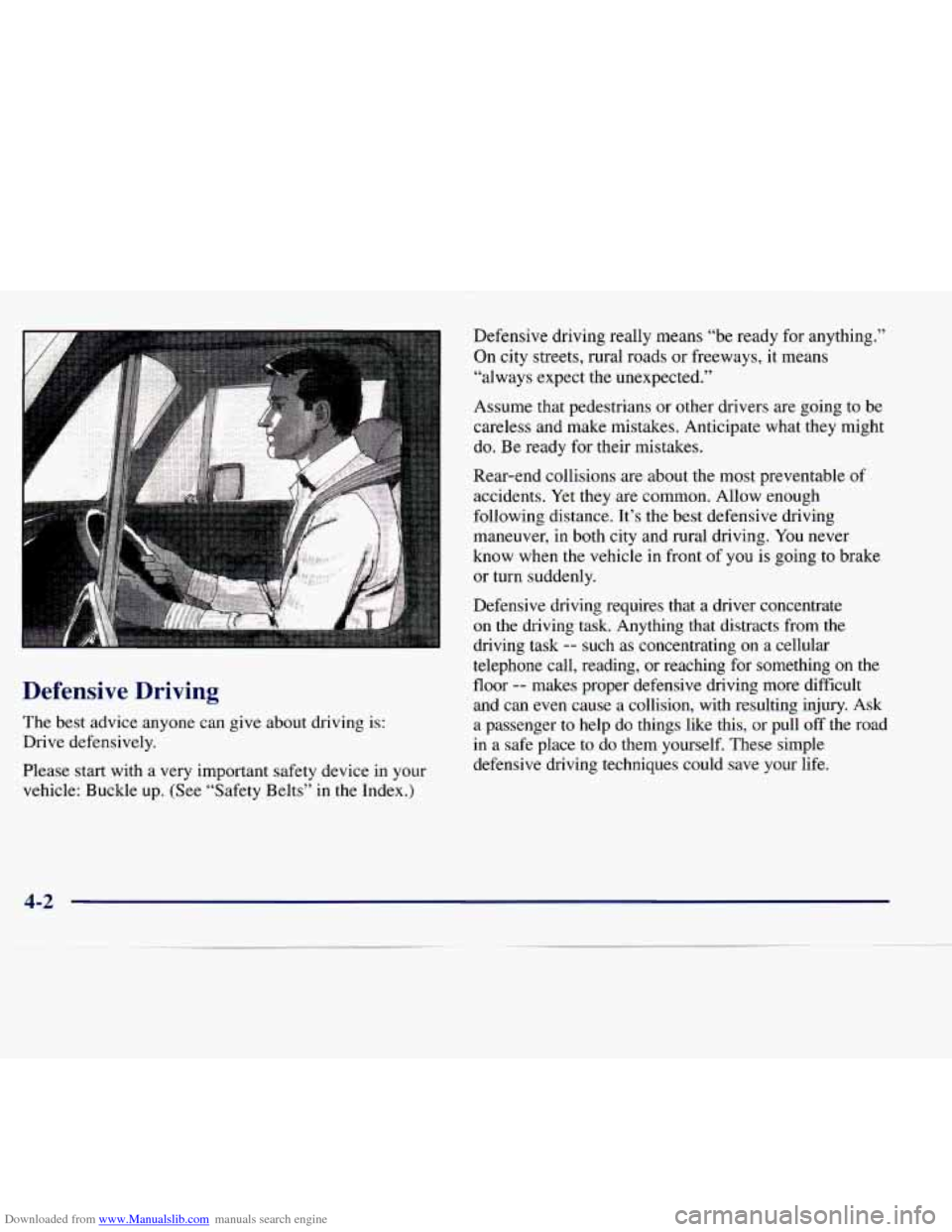
Downloaded from www.Manualslib.com manuals search engine Defensive driving really means “be ready for anything.”
On city streets, rural roads or freeways, it means
“always expect the unexpected.”
Assume that pedestrians or other drivers are going to be
careless and make mistakes. Anticipate what they might
do. Be ready for their mistakes.
Rear-end collisions are about the most preventable
of
accidents. Yet they are common. Allow enough
following distance. It’s the best defensive driving
maneuver, in both city and rural driving. You never
know when the vehicle
in front of you is going to brake
or turn suddenly.
Defensive driving requires that a driver concentrate on
the driving task. Anything that distracts from the
driving task
-- such as concentrating on a cellular
telephone call, reading, or reaching for something
on the
floor
-- makes proper defensive driving more difficult
and can even cause a collision, with resulting injury. Ask
a passenger to help do things like this, or pull
off the road
in a safe place to do them yourself. These simple
defensive driving techniques could save your life.
Defensive Driving
The best advice anyone can give about driving is:
Drive defensively.
Please start with a very important safety device in your
vehicle: Buckle up. (See “Safety Belts” in
the Index.)
4-2
Page 180 of 386
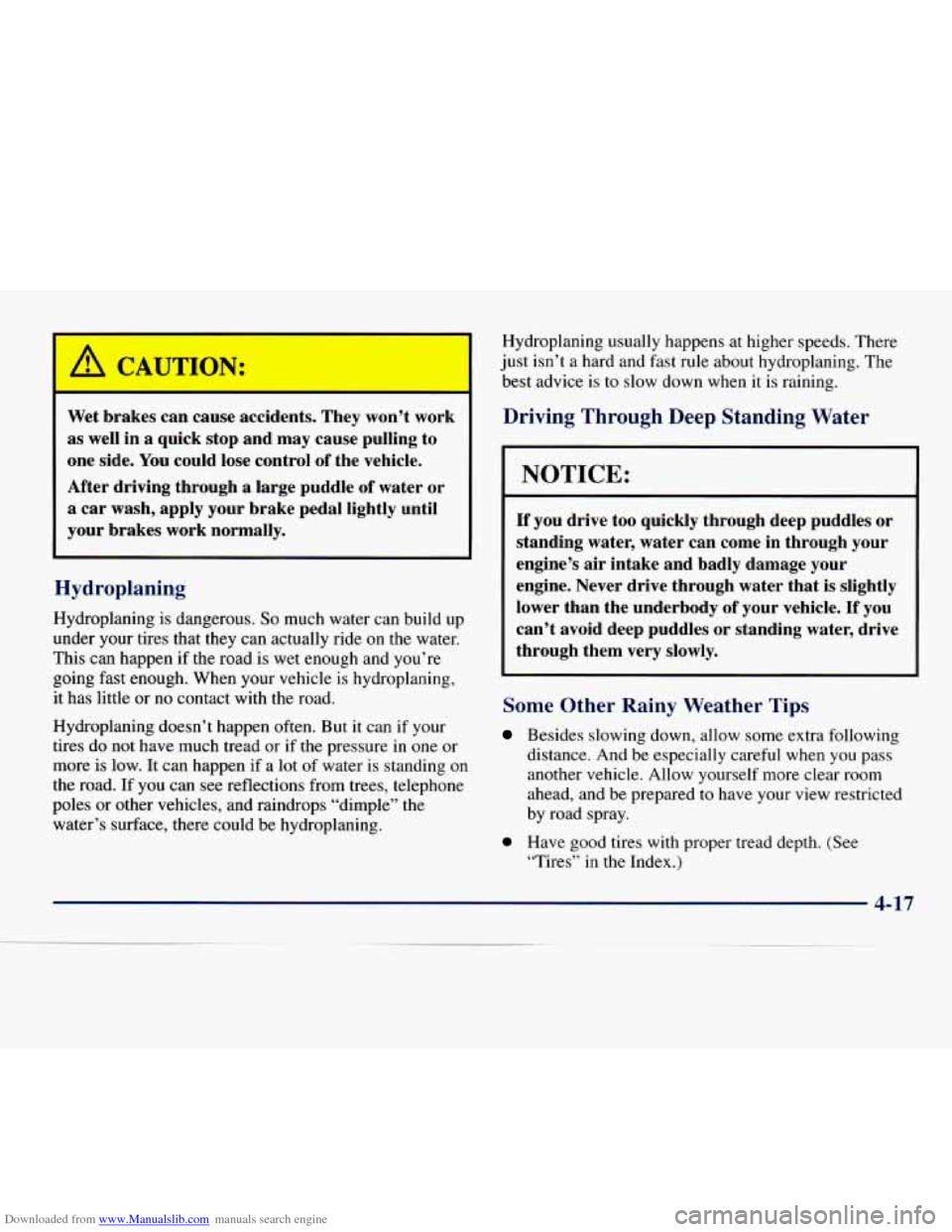
Downloaded from www.Manualslib.com manuals search engine A CAUTION:
Wet brakes can cause accidents. They won’t work
as well in a quick stop and may cause pulling to
one side. You could lose control
of the vehicle.
After driving through
a large puddle of water or
a car wash, apply your brake pedal lightly until
your brakes work normally.
Hydroplaning
Hydroplaning is dangerous. So much water can build up
under your tires that they can actually ride on the water.
This can happen if the road is wet enough and you’re
going fast enough. When your vehicle is hydroplaning,
it has little or
no contact with the road.
Hydroplaning doesn’t happen often. But
it can if your
tires do not have much tread or if the pressure in
one or
more is low. It can happen if a lot
of water is standing on
the road. If you can see reflections from trees, telephone
poles or other vehicles, and raindrops “dimple” the
water’s surface, there could be hydroplaning. Hydroplaning
usually happens at higher speeds. There
just isn’t a hard and fast rule about hydroplaning. The
best advice is to slow down when
it is raining.
Driving Through Deep Standing Water
NOTICE:
If you drive too quickly through deep puddles or
standing water, water can come
in through your
engine’s air intake and badly damage your
engine. Never drive through water that is slightly
lower than the underbody
of your vehicle. If you
can’t avoid deep puddles or standing water, drive
through them very slowly.
Some Other Rainy Weather Tips
Besides slowing down, allow some extra following
distance. And be especially careful when you pass
another vehicle. Allow yourself more clear room
ahead, and be prepared to have your view restricted
by road spray.
0 Have good tires with proper tread depth. (See
“Tires”
in the Index.)
4-17
Page 360 of 386
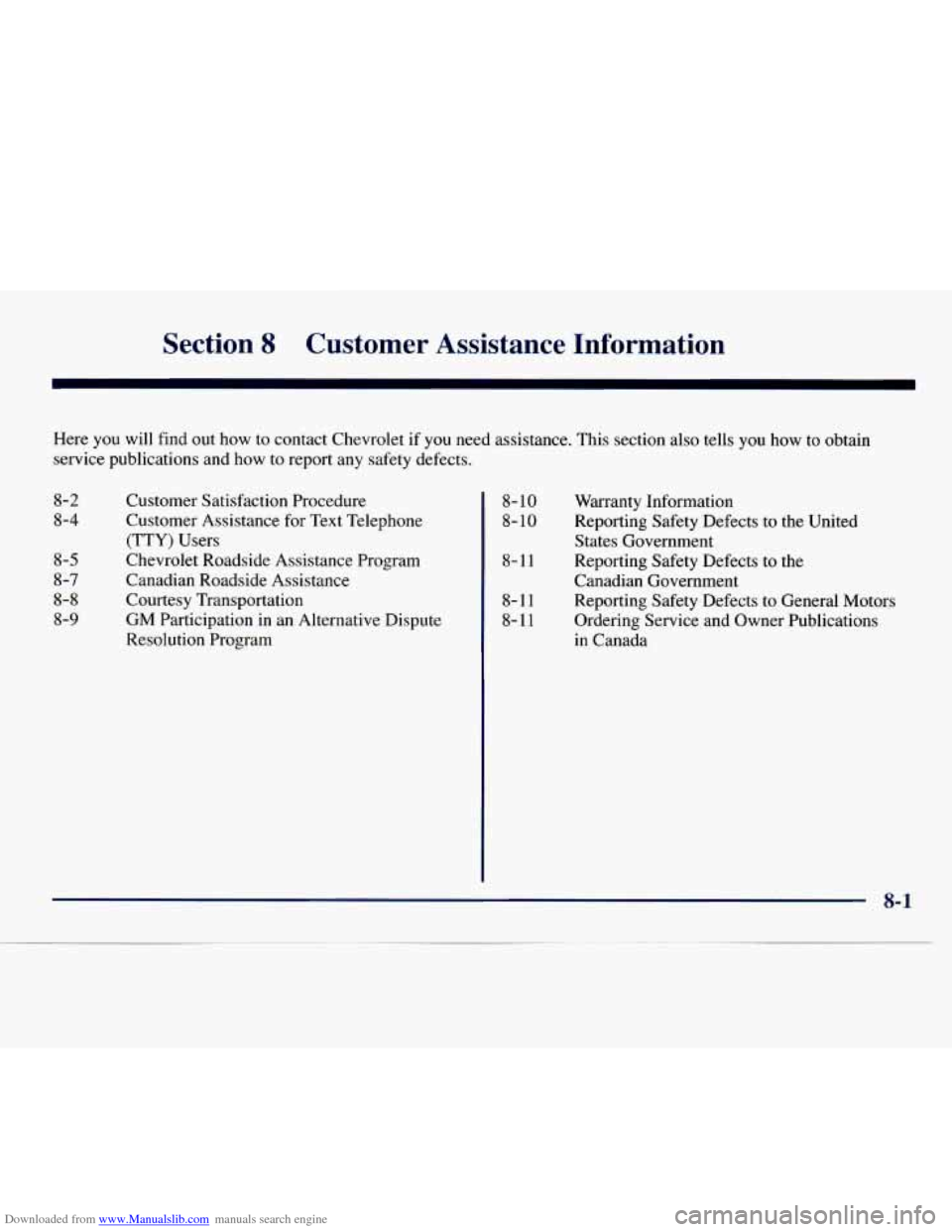
Downloaded from www.Manualslib.com manuals search engine Section 8 Customer Assistance Information
Here you will find out how to contact Chevrolet if you need assistance. This section also tells you how to obtain
service publications and how to report any safety defects.
8-2
8-4
8-5
8-7
8-8
8-9
Customer Satisfaction Procedure
Customer Assistance for Text Telephone
(TTY) Users
Chevrolet Roadside Assistance Program
Canadian Roadside Assistance
Courtesy Transportation
GM Participation in an Alternative Dispute
Resolution Program 8-
10
8- 10
8-11
8-11 8-11 Warranty
Information
Reporting Safety Defects to the United
States Government
Reporting Safety Defects to the
Canadian Government Reporting Safety Defects to General Motors
Ordering Service and Owner Publications
in Canada
8-1
Page 363 of 386
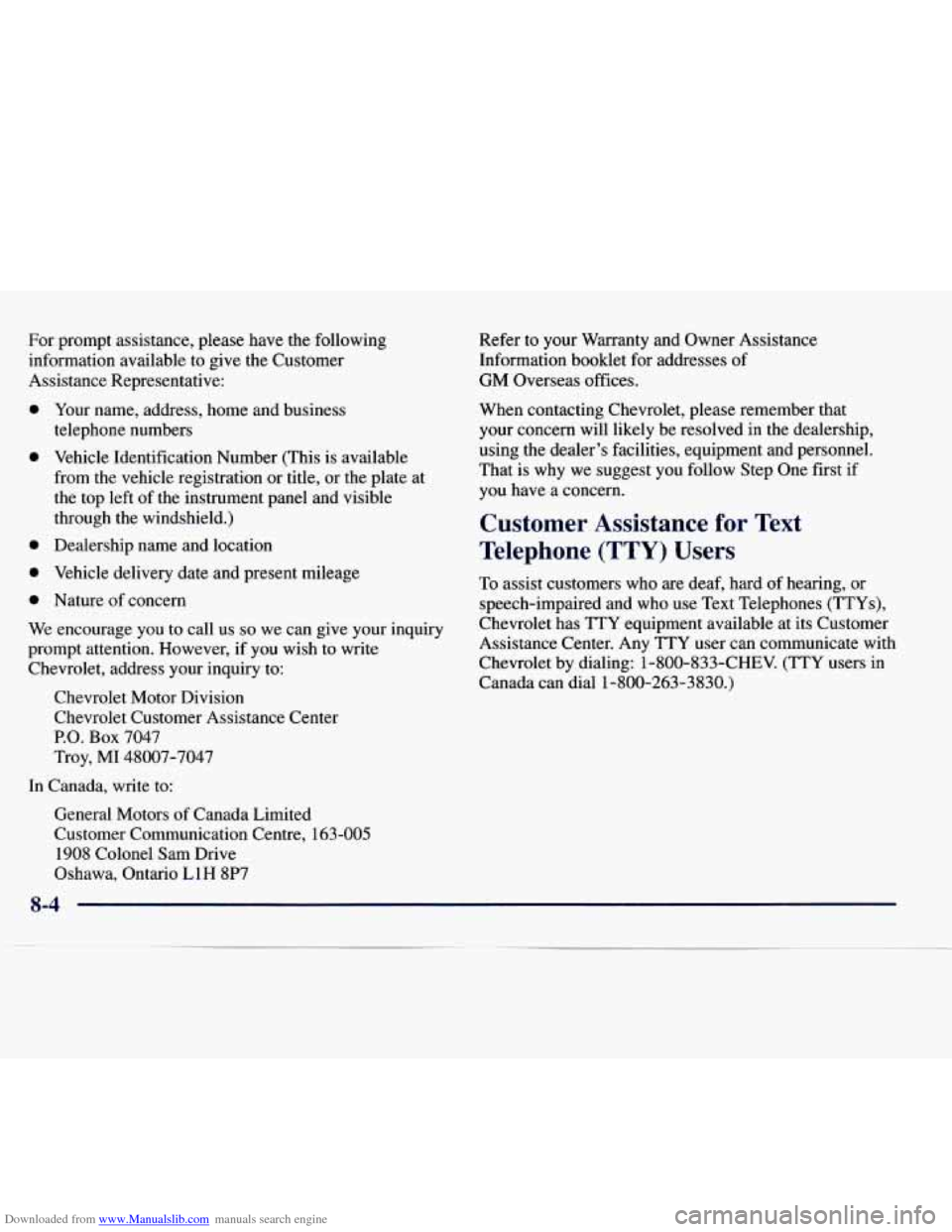
Downloaded from www.Manualslib.com manuals search engine For prompt assistance, please have the following
information available to give the Customer
Assistance Representative:
0
0
0
0
0
Your name, address, home and business
telephone numbers
Vehicle Identification Number (This is available
from
the vehicle registration or title, or the plate at
the top left
of the instrument panel and visible
through the windshield.)
Dealership name and location
Vehicle delivery date and present mileage
Nature
of concern
We encourage you to call
us so we can give your inquiry
prompt attention. However, if you wish to write
Chevrolet, address your inquiry
to:
Chevrolet Motor Division
Chevrolet Customer Assistance Center
P.O. Box 7047
Troy, MI 48007-7047
In Canada, write to: General Motors
of Canada Limited
Customer Communication Centre,
163-005
1908 Colonel Sam Drive
Oshawa, Ontario
LlH 8P7 Refer
to your Warranty and Owner Assistance
Information booklet for addresses
of
GM Overseas offices.
When contacting Chevrolet, please remember that
your concern will likely be resolved in the dealership,
using the dealer’s facilities, equipment and personnel.
That is
why we suggest you follow Step One first if
you have a concern.
Customer Assistance for Text
Telephone
(TTY) Users
To assist customers who are deaf, hard of hearing, or
speech-impaired and who use Text Telephones (TTYs),
Chevrolet has TTY equipment available at its Customer
Assistance Center. Any TTY user can communicate with
Chevrolet by dialing: 1-800-833-CHEV. (TTY users in
Canada can dial 1-800-263-3830.)
8-4
Page 364 of 386
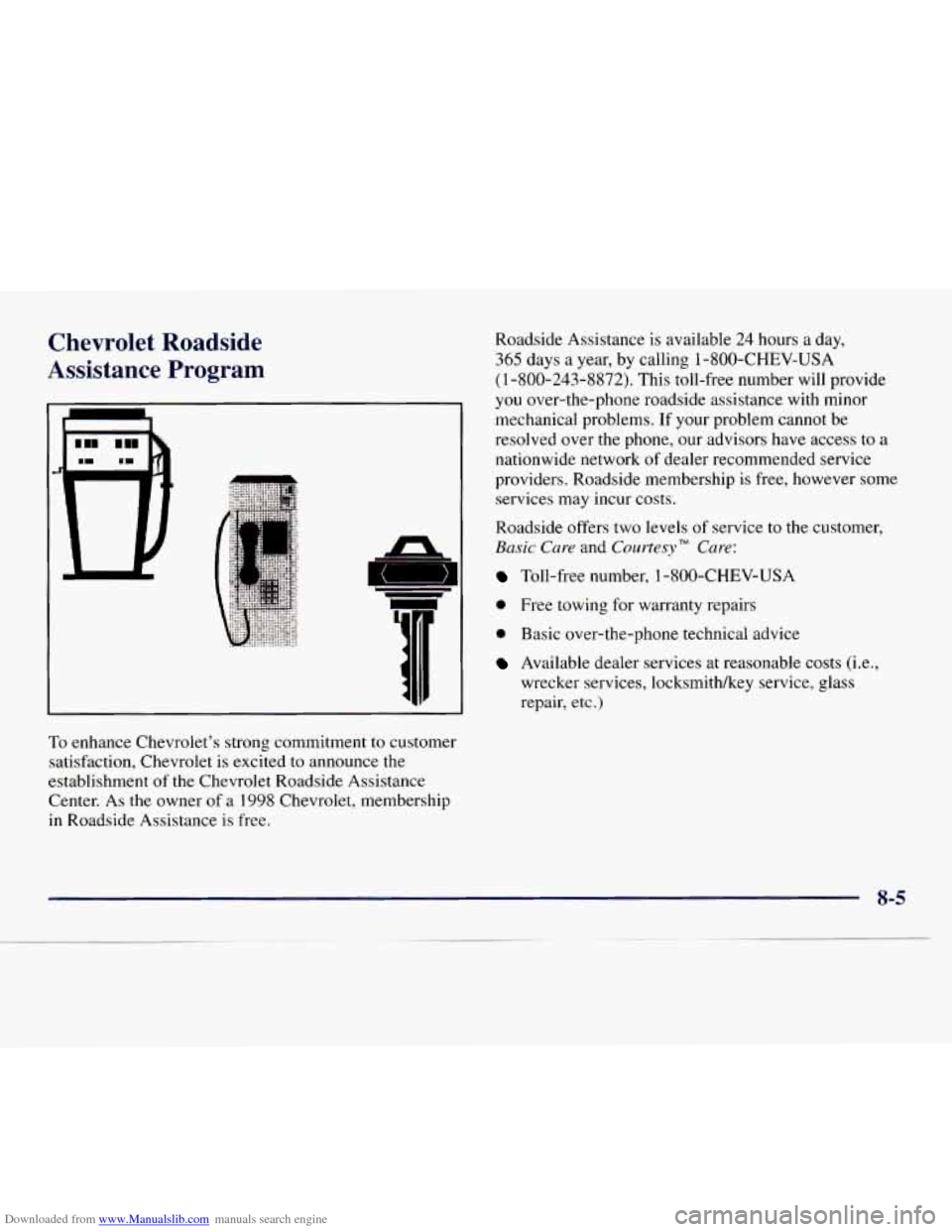
Downloaded from www.Manualslib.com manuals search engine Chevrolet Roadside
Assistance Program
To enhance Chevrolet’s strong commitment to customer
satisfaction, Chevrolet is excited
to announce the
establishment
of the Chevrolet Roadside Assistance
Center.
As the owner of a 1998 Chevrolet, membership
in Roadside Assistance is free. Roadside Assistance
is available
24 hours a day,
365 days a year, by calling 1-800-CHEV-USA
(1 -800-243-8872). This toll-free number will provide
you over-the-phone roadside assistance with minor
mechanical problems. If your problem cannot be
resolved over the phone, our advisors have access to
a
nationwide network of dealer recommended service
providers. Roadside membership is free, however some
services may incur costs.
Roadside offers two levels
of service to the customer,
Basic Care and Courtesy” Care:
Toll-free number, 1 -800-CHEV-USA
0 Free towing for warranty repairs
0 Basic over-the-phone technical advice
Available dealer services at reasonable costs (i.e,,
wrecker services, locksmithkey service, glass
repair, etc.)
Page 366 of 386

Downloaded from www.Manualslib.com manuals search engine For complete program details, see your Chevrolet dealer
to obtain a Roadside Assistance Center brochure.
The Roadside Assistance Center uses companies that
will provide you
with quality and priority service. When
roadside services are required, our advisors will explain
any payment obligations that may be incurred for
utilizing outside services.
For prompt assistance when calling, please have the
following available to give to the advisor:
0
0
0
0
0
0
0
Vehicle Identification Number (VIN)
License plate number
Vehicle color
Vehicle location
Telephone number where you can be reached
Vehicle mileage
Description
of problem Please refer
to the Roadside
Assistance brochure
inside your owner information portfolio for full
program details.
Canadian Roadside Assistance
Vehicles purchased in Canada have an extensive
Roadside Assistance program accessible from anywhere
in Canada or the United States. Please refer to the
separate brochure provided by the dealer or call
1-800-268-6800 for emergency services.